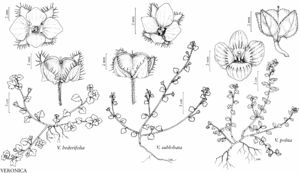Difference between revisions of "Veronica sublobata"
Oesterr. Bot. Z. 114: 201, 227, figs. 3c, 4c. 1967.
FNA>Volume Importer |
imported>Volume Importer |
||
| (One intermediate revision by the same user not shown) | |||
| Line 39: | Line 39: | ||
|elevation=0–1000 m. | |elevation=0–1000 m. | ||
|distribution=Ala.;Ky.;Md.;Mo.;Ohio;Utah;Va.;Europe. | |distribution=Ala.;Ky.;Md.;Mo.;Ohio;Utah;Va.;Europe. | ||
| + | |introduced=true | ||
|discussion=<p><i>Veronica sublobata</i> is closely related to <i>V. hederifolia</i> and has been frequently synonymized with or treated as a subspecies of the latter. It has rarely been reported in the flora area and is surely more widespread than indicated above. It seems to be more rare than <i>V. hederifolia</i> with only about a dozen verified records from seven states. However, its frequent occurrence in cultivated habitats in Europe makes it likely that it has been introduced to the flora area on multiple occasions.</p> | |discussion=<p><i>Veronica sublobata</i> is closely related to <i>V. hederifolia</i> and has been frequently synonymized with or treated as a subspecies of the latter. It has rarely been reported in the flora area and is surely more widespread than indicated above. It seems to be more rare than <i>V. hederifolia</i> with only about a dozen verified records from seven states. However, its frequent occurrence in cultivated habitats in Europe makes it likely that it has been introduced to the flora area on multiple occasions.</p> | ||
|tables= | |tables= | ||
| Line 63: | Line 64: | ||
|publication year=1967 | |publication year=1967 | ||
|special status=Introduced;Illustrated | |special status=Introduced;Illustrated | ||
| − | |source xml=https:// | + | |source xml=https://bitbucket.org/aafc-mbb/fna-data-curation/src/2e0870ddd59836b60bcf96646a41e87ea5a5943a/coarse_grained_fna_xml/V17/V17_763.xml |
|genus=Veronica | |genus=Veronica | ||
|species=Veronica sublobata | |species=Veronica sublobata | ||
Latest revision as of 19:36, 5 November 2020
Annuals. Stems decumbent to ascending, sometimes erect in young plants, 5–40(–50) cm, eglandular-hairy. Leaves: blade ovate to broadly ovate, 5(–7)-lobed, central lobe longer than wide and broadest, (7–)9–15(–25) × (7–)9–17(–27) mm, base truncate, margins 5(–7)-lobed, apex obtuse to rounded, surfaces sparsely eglandular-hairy. Racemes 1–10, terminal, 50–400(–500) mm, 5–20-flowered, axis eglandular-hairy; bracts broadly ovate, 5(–7)-lobed, central lobe longer than wide and broadest, (7–)9–15(–25) mm. Pedicels patent or deflexed, (7–)10–18(–24) mm, ± longer than subtending bract, length 3–4(–6) times calyx, eglandular-hairy (densely adaxially). Flowers: calyx lobes 3–4 mm, apex acute, sparsely hairy on abaxial surface or glabrous, ciliate with 25–35 hairs per side; corolla pale violet to whitish, 4–5(–6) mm diam.; stamens pale violet, 0.4–0.8 mm; style 0.2–0.7 mm. Capsules ± round in cross section, ovoid, 2–3 × 3.5–5 mm, apex ± emarginate, glabrate. Seeds 1–4, bright reddish brown, broadly ovoid to subglobular, urn-shaped, 2.2–2.7 × 2–2.4 mm, 1–1.8 mm thick, transverse ribs inconspicuous, thinner towards margin, margins strongly involute. 2n = 36 (Europe).
Phenology: Flowering Mar–May.
Habitat: Moist forests, damp, shady ruderal places, thickets, gardens, montane fields.
Elevation: 0–1000 m.
Distribution
Introduced; Ala., Ky., Md., Mo., Ohio, Utah, Va., Europe.
Discussion
Veronica sublobata is closely related to V. hederifolia and has been frequently synonymized with or treated as a subspecies of the latter. It has rarely been reported in the flora area and is surely more widespread than indicated above. It seems to be more rare than V. hederifolia with only about a dozen verified records from seven states. However, its frequent occurrence in cultivated habitats in Europe makes it likely that it has been introduced to the flora area on multiple occasions.
Selected References
None.
